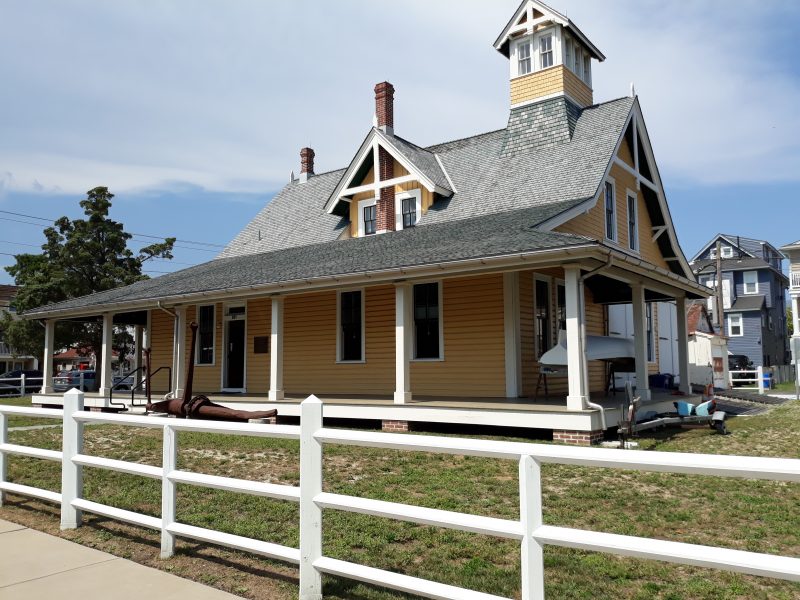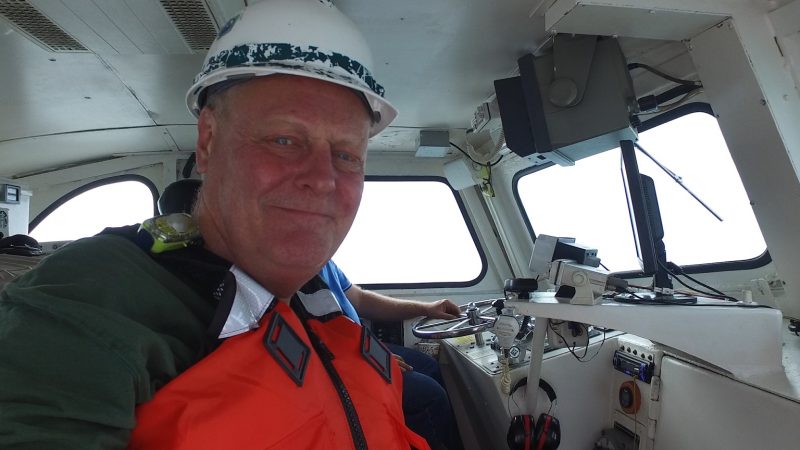Martin Fiedler, in the center of the action during production of a construction documentation job. (Photo courtesy Martin Fiedler)
 By TIM KELLY
“A picture is worth a thousand words.” – Age-old saying
If the proverbial value placed on a visual image is correct, then Martin Fiedler has created an encyclopedic history of the United States Coast Guard’s ancestor, the U.S. Life Saving Service, in a new video series.
When it comes to telling stories on video, few are as accomplished or experienced as Fiedler. Thus, his broadcast-quality series documenting the Life Saving Service, its brave first responders of the day, known as Surfmen, and Ocean City’s historic Life Saving Station 30 bears the imprint of a man who cares deeply about his subject.
“That is what I try to bring to every project that I take on,” says Fiedler, whose list of experiences include electronic news gathering (at the former WMGM TV-40, and as a contributor to many other news outlets), writing, and every type of commercial work imaginable.
It’s an impressive resume.
As is the video series on the Life Saving Station and Service. It seeks to recognize a branch of the United States government that has never received its due, and has largely been forgotten in the history books.
“They were courageous men,” Lifeguard Station 30 curator John Loeper said of the surfmen.
Loeper’s stories of the Service, its Ocean City station and the men who worked there are dramatically captured and woven throughout the video series.
https://youtu.be/34L1LWMKL6g
(The first installment in the new video series about Ocean City’s Life Saving Station 30, its people and its mission).
Now a public museum, the station at Fourth Street and Atlantic Avenue has been meticulously and historically restored to reflect what it would have looked like and been equipped during its heyday in the late 19th and early 20th century.
“They lived a lonely, spartan existence when they weren’t out making rescues,” Loeper said of the Service members. “They were paid, but they were responsible for their own food. They also had to feed the people they rescued until their relatives could be contacted and the survivors found a way to go home. So every week they would go out crabbing, clamming, fishing and hunting to bring whatever food they could into the station.”
The first and future installments of the series, providing an overview of the U.S. Life Saving Service, its men, and the station in Ocean City, can be found at the Station’s website at
By TIM KELLY
“A picture is worth a thousand words.” – Age-old saying
If the proverbial value placed on a visual image is correct, then Martin Fiedler has created an encyclopedic history of the United States Coast Guard’s ancestor, the U.S. Life Saving Service, in a new video series.
When it comes to telling stories on video, few are as accomplished or experienced as Fiedler. Thus, his broadcast-quality series documenting the Life Saving Service, its brave first responders of the day, known as Surfmen, and Ocean City’s historic Life Saving Station 30 bears the imprint of a man who cares deeply about his subject.
“That is what I try to bring to every project that I take on,” says Fiedler, whose list of experiences include electronic news gathering (at the former WMGM TV-40, and as a contributor to many other news outlets), writing, and every type of commercial work imaginable.
It’s an impressive resume.
As is the video series on the Life Saving Station and Service. It seeks to recognize a branch of the United States government that has never received its due, and has largely been forgotten in the history books.
“They were courageous men,” Lifeguard Station 30 curator John Loeper said of the surfmen.
Loeper’s stories of the Service, its Ocean City station and the men who worked there are dramatically captured and woven throughout the video series.
https://youtu.be/34L1LWMKL6g
(The first installment in the new video series about Ocean City’s Life Saving Station 30, its people and its mission).
Now a public museum, the station at Fourth Street and Atlantic Avenue has been meticulously and historically restored to reflect what it would have looked like and been equipped during its heyday in the late 19th and early 20th century.
“They lived a lonely, spartan existence when they weren’t out making rescues,” Loeper said of the Service members. “They were paid, but they were responsible for their own food. They also had to feed the people they rescued until their relatives could be contacted and the survivors found a way to go home. So every week they would go out crabbing, clamming, fishing and hunting to bring whatever food they could into the station.”
The first and future installments of the series, providing an overview of the U.S. Life Saving Service, its men, and the station in Ocean City, can be found at the Station’s website at  The U.S. Life Saving Station, now a museum, was used to rescue passengers and crew members from Ocean City shipwrecks.
In addition to Loeper’s interviews, there are rare photographs and films, looks at the station’s artifacts and much more. The viewer learns that there are 470 shipwrecks off New Jersey between New York and Cape May.
Fiedler’s background in TV news is evident in the style of the documentary and the delivery of its message. Though slickly produced and edited, technology never gets in the way of the story, and John Loeper is a master storyteller.
“North Carolina is called the graveyard of the Atlantic, but New Jersey really is,” Loeper said. “At this station there were (on average) four wrecks a month to be dealt with. Nationwide, the Life Saving Service saved more than 170,000 people during its existence.”
The series’ narration is delivered in stirring fashion by professional voiceover artist, Maryann Pionegro-Smith. Fiedler also lauded the contributions of his daughter Becca Stewart of Eyely Design, which designed and hosted the website, copywriting by Ocean City native Bette Kaminski, and his brother Steve Fiedler, who assisted on the Loeper interviews.
Fiedler also produced content and set up an interactive touchscreen presentation at the Station for its visitors to learn more about the Station.
“One of the great things about the story of the Station and its people is the fact there is something for anyone to relate to,” said Fiedler. “Men, women, kids, all can relate to different aspects of the story. If they visit a second or a third time they are going to keep seeing things that are new.”
Fiedler, whose Just Right TV Productions is based in Mays Landing, is no rookie when it comes to projects involving Ocean City.
“I’ve been producing video work in Ocean City for at least 20 years,” he said, “or approximately half of my career.”
The U.S. Life Saving Station, now a museum, was used to rescue passengers and crew members from Ocean City shipwrecks.
In addition to Loeper’s interviews, there are rare photographs and films, looks at the station’s artifacts and much more. The viewer learns that there are 470 shipwrecks off New Jersey between New York and Cape May.
Fiedler’s background in TV news is evident in the style of the documentary and the delivery of its message. Though slickly produced and edited, technology never gets in the way of the story, and John Loeper is a master storyteller.
“North Carolina is called the graveyard of the Atlantic, but New Jersey really is,” Loeper said. “At this station there were (on average) four wrecks a month to be dealt with. Nationwide, the Life Saving Service saved more than 170,000 people during its existence.”
The series’ narration is delivered in stirring fashion by professional voiceover artist, Maryann Pionegro-Smith. Fiedler also lauded the contributions of his daughter Becca Stewart of Eyely Design, which designed and hosted the website, copywriting by Ocean City native Bette Kaminski, and his brother Steve Fiedler, who assisted on the Loeper interviews.
Fiedler also produced content and set up an interactive touchscreen presentation at the Station for its visitors to learn more about the Station.
“One of the great things about the story of the Station and its people is the fact there is something for anyone to relate to,” said Fiedler. “Men, women, kids, all can relate to different aspects of the story. If they visit a second or a third time they are going to keep seeing things that are new.”
Fiedler, whose Just Right TV Productions is based in Mays Landing, is no rookie when it comes to projects involving Ocean City.
“I’ve been producing video work in Ocean City for at least 20 years,” he said, “or approximately half of my career.”
 Martin Fiedler is in the center of the action during production of a construction documentation job. (Photo courtesy Martin Fiedler)
In addition to his actual video productions, Fiedler’s services include video consulting, post production, documentation for construction jobs, tourism videos for municipalities and healthcare industry documentation. He can be reached through the website www.justrighttv.com.
“There’s not much we haven’t done,” Fiedler said, “but we’re always willing to try something new.”
That would not include this series, as Fiedler estimates he’s done “hundreds” of documentaries over the years. His experience shows. There was, however, something different about this project, he conceded.
“The more I learned about the subject, the more I came to realize this story is something special. It’s an absolute privilege to help tell the story of the Station’s history and to preserve it for future generations.”
Martin Fiedler is in the center of the action during production of a construction documentation job. (Photo courtesy Martin Fiedler)
In addition to his actual video productions, Fiedler’s services include video consulting, post production, documentation for construction jobs, tourism videos for municipalities and healthcare industry documentation. He can be reached through the website www.justrighttv.com.
“There’s not much we haven’t done,” Fiedler said, “but we’re always willing to try something new.”
That would not include this series, as Fiedler estimates he’s done “hundreds” of documentaries over the years. His experience shows. There was, however, something different about this project, he conceded.
“The more I learned about the subject, the more I came to realize this story is something special. It’s an absolute privilege to help tell the story of the Station’s history and to preserve it for future generations.”